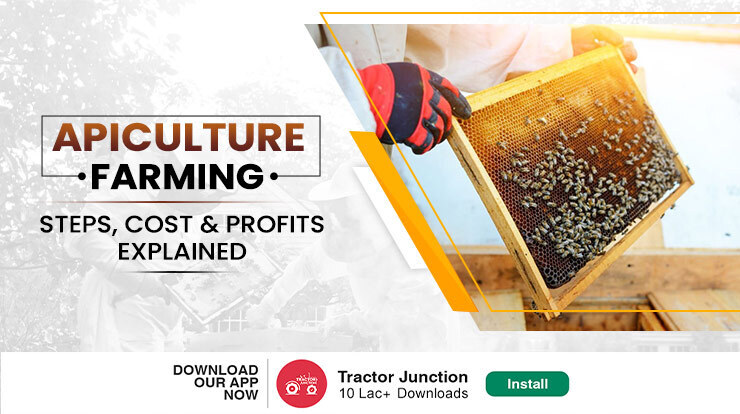
Apiculture Introduction!
Do you know; Beekeeping started first 9,0000 years ago in small pottery vessels in North Africa?
The practice became popular and was first introduced in Madras regions in 1931. Later in Punjab in 1933 & further in Uttar Pradesh in 1938. On seeing the popularity, the All India Beekeepers Association was developed during 1938–39. Moreover, the first Beekeeping Research Station was in 1945 in Punjab by the Indian Council of Agricultural Research.
Now you know the history of apiculture. Further, let’s understand what apiculture farming is, how it is beneficial and what tools and investment it requires to get started.
What is Apiculture?
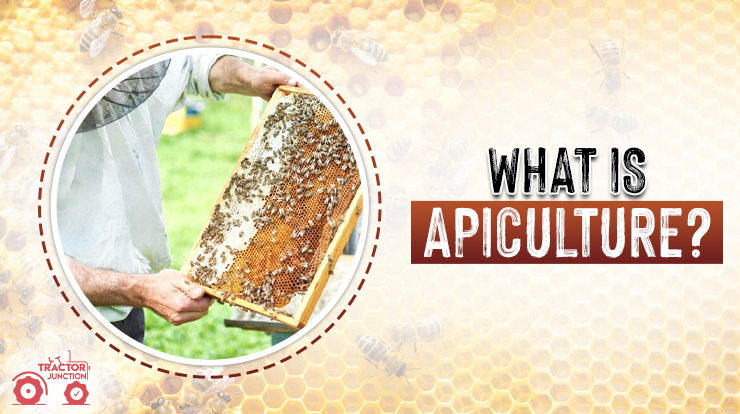
The word “Apiculture” is a scientific method that involves the rearing of honeybees. In Latin, the word ‘apis‘ means bees. Apiculture, also known as beekeeping, involves rearing and managing honey bees in hives or related structural setups to extract their honey/wax.
Honey bees extract nectar from pollinating flowers and convert it into honey. Further, they store in the combs of the hive.
Read: How to Start Honey Farming in India?
Benefits of Apiculture
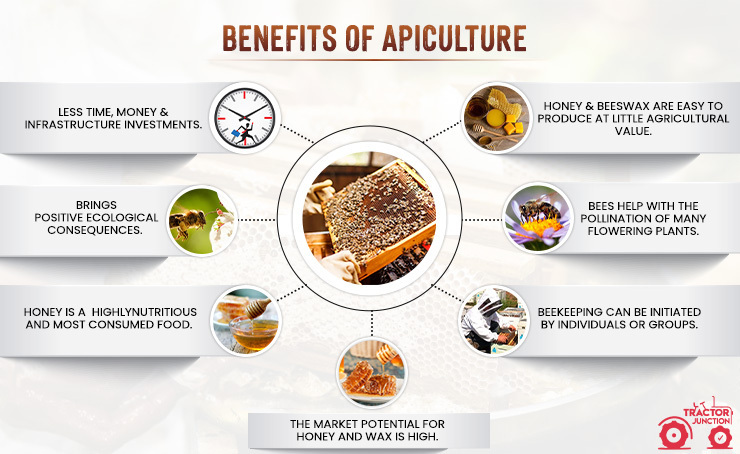
Apiculture is a modern beekeeping farming method that serves a variety of benefits once practised. Now, let’s review some of the advantages of apiculture in India:
- The process of rearing bees is less time-consuming and quite cost-effective as it requires fewer infrastructure investments.
- You just need a little farm area to procure honey and beeswax for commercial purposes.
- The honey bee doesn’t require many agricultural resources compared to other modern farming methods.
- Beekeeping helps boost the pollination process of flowering plants, which in turn helps increase the yield for various flowers like sunflowers and other fruits.
- Honey is a widely accepted condiment. India alone produces 1,33,200 metric tonnes of honey annually. This market is now worth Rs 3,000 crore.
- Honey acids are best at being antidepressant & antibacterial; additionally, it offers anticonvulsant and anti-anxiety benefits. Moreover, some people find it helpful in solving memory disorders. Additionally, this antibacterial substance is also proven to heal wounds & burns and is a great choice for pre-workout.
- Beekeeping is a great business option as it’s easy to initiate by either individuals or groups.
- The market potential for honey and wax is high; experts say the market is about to reach a valuation of INR 44,814.7 Million by 2028.
Here are commonly popular bee species reared in India.
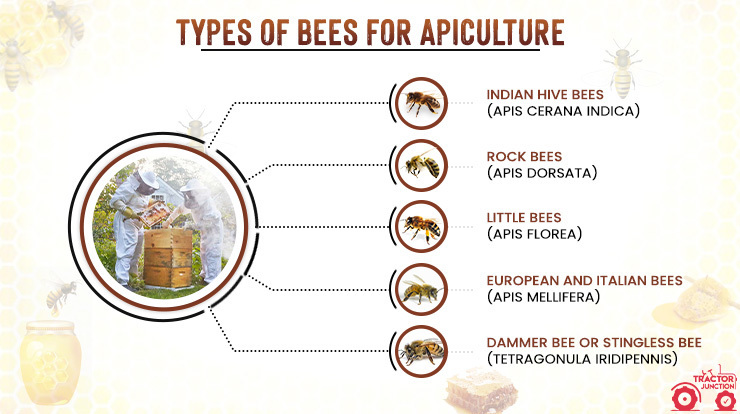
Famous Varieties of Bees Reared in a Comb
Here are some different species of bees that are popular to produce good-quality honey:
- Apis florea
- Indica
- Apis dorsata
- Apis mellifera
These are the types of apiculture in India. The apiculture process involves the management and rearing of different species of honeybees. Therefore, in the process, Types of Bees in Apiculture are reared and bred in apiaries for commercial purposes.
What’s an Apiary?
Apiary is a place where a large number of beehives can be kept. Here, the bees are kept and managed end-to-end to produce wax & honey.
Top Equipment Needed for Apiculture
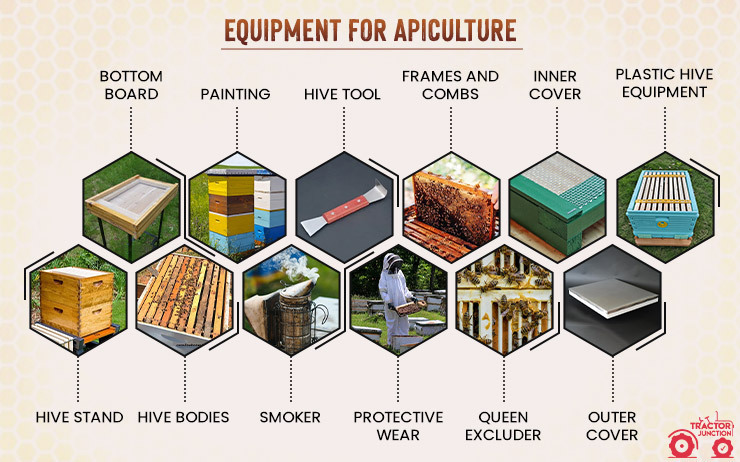
Apiculture is an easy process that involves just a few easy-to-access equipment as follows:
-
Hive
A hive or beehive is an enclosed structure with a number of slats (top bars). The hive makes subgenus Apis species live and raise their young. Moreover, the beehive box should be 100 cm long, 45 cm wide & 25 cm in height. And the entrance holes should be 1 cm wide.
-
Smoker
A bee smoker is a device that is created from tin to calm and control honey bees. It is generally made from a stainless steel cylinder, having a narrowing lid to a gap with a half-inch diameter.
Other Additional Equipment for Apiculture/Beekeeping
- You would need a cloth to cover & protect the eyes & nose from stings while working close to the apiary.
- You would need a sharp knife to cut the honey bars.
- Also, you would need some feathers or any equipment to make the bees come out of the comb.
- Queen Excluder – A selective barrier inside the beehive makes the beekeepers transverse the barrier but restricts the larger queen and drones.
- Matchbox – The best way to imprison the bees and prevent them from escaping or fighting.
Find out – Top 10 4WD Tractors in India
Popular Varieties of Honey Extracted Through Apiculture
- Rapeseed/mustard honey
- Eucalyptus honey
- Lychee honey
- Sunflower honey
- Karanj/Pongamea honey
- Multi-flora honey
Successful Beekeeping Methods
You must ensure the following points for performing safe & effective methods of beekeeping.
- Gather knowledge of bee habits, right from mating through depositing eggs. You must also know how to collect nectar, nurse for larvae, and build the comb.
- Select a suitable location for beehives that doesn’t overheat. Moreover, choose a location where it’s easy to access bee pastures or allow bees to go & collect nectar.
- Manage beehives in all seasons. Note that blossoming happens only in specific seasons. Moreover, maintain a sugar syrup reserve or note blossoming seasons to keep up with the market demand.
- Effective collection & handling of honey. Wear protective gear or use some smoke to keep bees at bay while procuring honey & beeswax. Moreover, ensure that the hives have sufficient honey for harvesting purposes.
- Gather colonies of bees. You can capture the already created colony of bees from government or privately owned organisations involved in rearing.
These are the Different Methods of Apiculture in India. You can follow any and generate lots of revenue from beekeeping in India.
Read More – Apply for a tractor loan without collateral & get instant approval!
Best Month for Apiculture or Beekeeping
Spring is the best time to rear the species of bees for apiculture. After the subset of cold seasons, there is an increase in forage, which makes the surroundings ideal for a new hive. Moreover, it also gets easier to increase the number of bee colonies.
After spring, you will notice the weather turning a little warmer and flowers blooming. Blooming flowers give bees the scope to extract more nectar for transforming it into honey or wax.
During the spring season, plan the time well, and allow the bees to gather as much nectar as possible to start the process. Make the hives ready before the season arrives.
Factors Affecting Apiculture in India
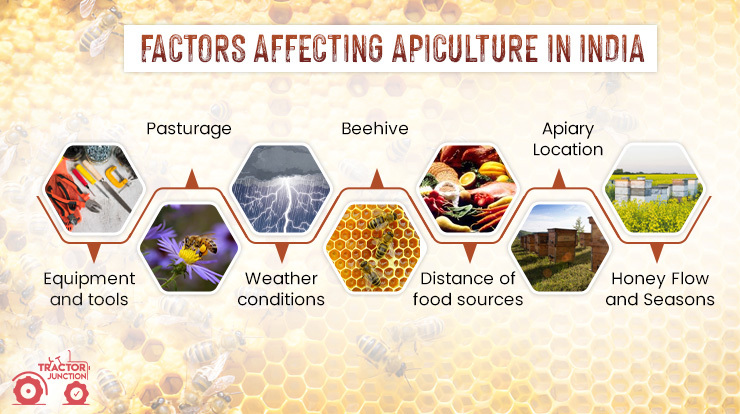
There are a number of different categories into which factors influencing apiculture, or beekeeping, can be divided. Among the crucial elements are:
- Equipment and tools: Access to improved hives, tools, and harvesting gears is essential for efficient beekeeping.
- Pasturage: The crops, flora, or pasturage that is accessible for the nectar and pollen collection determines the flavour and aroma of honey. Mango, coconut, almond, and other flowering plants are among the honey bee flora.
- Weather conditions: Temperature, wind, and precipitation can influence foraging behavior and honey production.
- Beehive: A beehive is a kind of box used to raise honey bees. A wire mesh with a multi-frame honey chamber is inside the box to aid in egg laying and honey collection. In India, there are primarily three varieties of beehives: Langstroth, Newton, and Jeolikote.
- Distance of food sources: The proximity of food sources to hives can impact foraging efficiency.
- Apiary Location: Apiaries are permanent spaces where beehives are arranged to maximise nectar and pollen gathering in strategic areas. Apiary locations are typically chosen for their abundance of vegetation, especially flowering plants. Beehives should also be positioned on the east side. It also needs access to water nearby.
Honey Flow and Seasons: The amount of honey produced by honey is also influenced by the length of time that a plentiful supply of flora is present. The entire time it takes for honey bees to collect pollen and nectar is known as the honey flow period. To get a lot of honey, there must be a sufficient number of flowers.
Profit & Cost Analysis of Apiculture in India
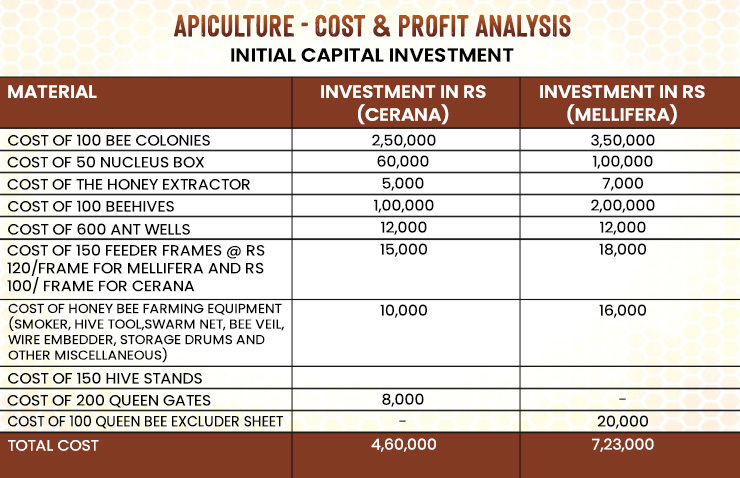
With apiculture, farmers can earn up to Rs 3 crore annually. Apiculture or beekeeping is turning out to be a profitable business with fewer investments, up to Rs 8 lakhs.
Training for Apiculture Project in India
India has various training institutes that deliver precise beekeeping or apiculture information through a well-planned curriculum. Moreover, by joining these institutions, you can get the upper hand on the information on the process of apiculture.
- Lifecycle of a bee or life in the beehive.
- Beehive nutrition.
- Apiary migration & management.
- Production & sales for honey and beehives.
- Pollination service of honeybees.
- Honey extraction & processing.
- Wax Collection & Processing.
- Method of Propolis Production.
- Queen Bee & Queen Cells management.
Find out – Local Tractor Dealers in your district or state
Leading States for Apiculture in India
- Punjab
- West Bengal
- Bihar
- Kerala
- Karnataka
- Uttar Pradesh
- Tamil Nadu
- Uttarakhand
Now we know the complete methods of apiculture, process, popular states, etc., let’s move towards understanding the economic importance of apiculture.
Scope of Apiculture in India
In India, the apiculture market size reached a valuation of INR 23,060.5 Million in the year 2022. The IMARC Group suspects that by 2028, the apiculture market is projected to hit INR 44,814.7 Million. This will portray a growth of 11.65% (CAGR) during 2023-2028.
Experts say the awareness of customers towards apiculture and the increase in the ayurvedic industry are reasons behind this industry’s growth. Moreover, on a commercial scale, people patronise the importance and commercial scalability of products like honey, propolis, royal jelly, beeswax, etc.
Currently, about 3 lakh rural residents and small and landless farmers are employed in apiculture. However, almost 61% of India’s total output for honey is achieved from states like West Bengal, Uttar Pradesh, Punjab, and Bihar. India is one of the leading exporters of honey. All 50% of produced honey is exported overseas, including 75–85% as apiary honey.
It is forecasted that the 10 million tonnes of honey production will increase crop production and increase the bee colony up to 600–700 million. Doing this will ultimately help employ an average of 215 lakh people across the apiculture industry in India.
Advantages and Disadvantages of Apiculture (Beekeeping)
Following, we are showing Advantages and Disadvantages of Apiculture.
Pros of Apiculture
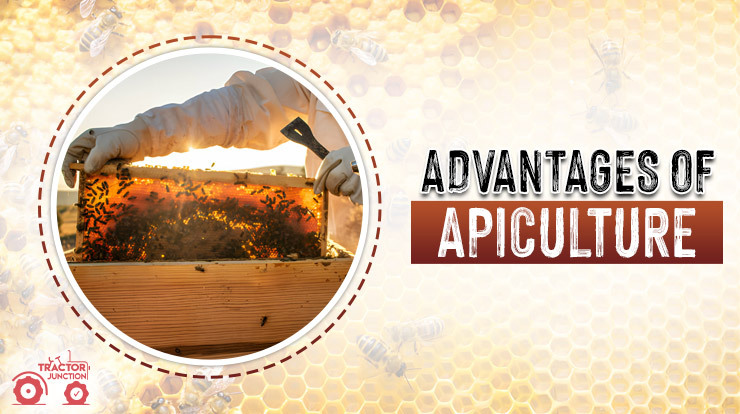
- Keeping bees, also known as apiculture, has some awesome perks. Bees help plants to make fruit, veggies, and nuts by spreading pollen.
- And of course, honey! It’s a natural sweetener we can thank bees for.
- Beeswax too, it’s used in many things like candles and cosmetics, and even in medicine.
- The bees also produce royal jelly which is super healthy for them and us.
- Got arthritis or a snake bite? Bee venom to the rescue!
- Bee keeping can also create jobs in rural areas.
- Plus, helping the environment is a big bonus. They keep our planet’s ecosystems going by pollinating plants, which is great for biodiversity.
Cons of Apiculture (Beekeeping)
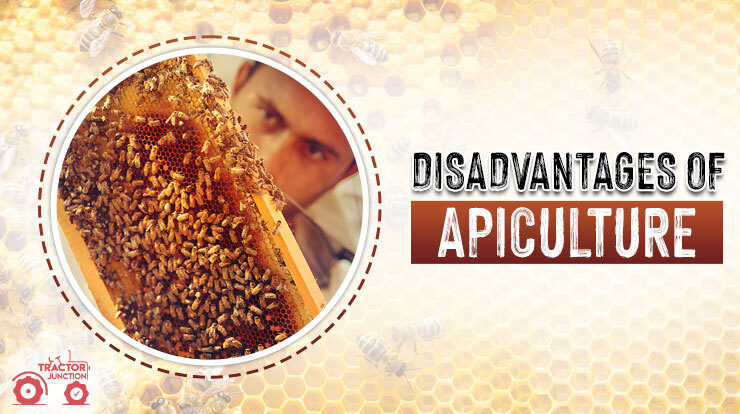
- Bee sting risk: Bees can sting. It hurts. For those allergic, it could be dangerous.
- Start-up cost: Buying beekeeping apiculture gear costs money. It’s a lot, especially for smaller beekeepers.
- Expertise needed: Beekeeping demands know-how to effectively handle bees.
- Sickness and pests: Bees get sick. They attract pests. Both hurt their health and honey-making.
- Weather-dependent income: Honey output depends on the weather, can mean unstable earnings.
- Government aid: Some places lack government aid and resources for beekeepers.
- Pesticide threat: Farm chemicals can hurt bees and their homes.
In general, beekeeping has more benefits than drawbacks. It’s a crucial farming method. It boosts food creation, provides job opportunities, and helps save the environment.
Conclusion of Apiculture!
The Apiculture Business is booming in India as the honey and wax demand is increasing. Experts have predicted that by 2028, the market will reach a valuation of INR 44,814.7 Million. In addition, by putting great rearing and management practices and investing a sum of up to INR 8-10 lakhs, they can earn up to INR 3 crores annually.
By apiculture, there is a boost in agricultural income. Moreover, with such farming practices, there is more availability of jobs. Also, this helps in improving the nutritional intake of the rural population. At present, about 3 lakh people are employed to sustain their livelihood.
For more information about apiculture in India and other related farming activities, stay tuned with TractorJunction blogs.
Frequently Asked Questions
Q1. What is apiculture?
Ans. The word “Apiculture” is a scientific method involving rearing and managing honeybees.
Q2. What is apiculture & how is it important in our lives?
Ans. Apiculture is a technique to procure honey & wax from bees for edible & other commercial purposes.
Q3. What is apiculture in science?
Ans. Apiculture’ is a Latin word in which ‘APIs’ means bees. It is a technical process of rearing & extracting honey & wax products from beehives.
Q4. What are the uses of apiculture?
Ans. Apiculture helps procure products like honey and wax. Besides the food grade industry, these two products have great vitality in the polishing, cosmetic, and pharmaceutical industries. Honey is also used in medicinal products and is often considered an additive food item.
Q5. What is the difference between apiculture and sericulture?
Ans. Apiculture is the rearing and breeding of beehives to get honey & was. At the same time, sericulture is the management of silkworms to attain silk.
Related Blog
A Guide to Dairy Farming
Why to do Rainwater Harvesting?
